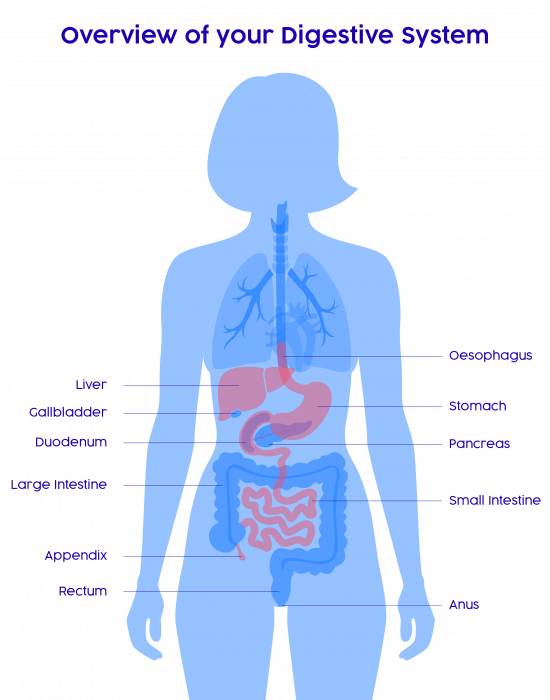Get the latest news from
The Gut Experts
To help understand the complexity and ingenuity of the digestive system we will take a brief whistle-stop journey down through your gut.

Your Mouth: The digestive process begins in your mouth. You chew your food, which helps to create a mulch that allows the food to mix with other digestive juices. The salivary glands in your mouth produce saliva that contains digestive enzymes and also lubricates the food, making it easier to swallow. Once you have chewed your food, when you swallow the food now passes into the oesophagus.
The Oesophagus (esophagus): This is a narrow tube, approximately 20cms long, which connects your mouth to your stomach. Muscle contractions (peristalsis) push the food down the oesophagus into the stomach. There is a valve-like structure (sphincter) at the lower end of the oesophagus which relaxes to allow food to enter the stomach and then contracts again and this prevents food and acid from the stomach flowing back into the oesophagus. When this sphincter is not working properly you may experience acid reflux or heartburn, (GORD or GERD).
The Stomach: The stomach is a muscular sac-like organ that can stretch to hold food when we eat. Its peristalsis mixes and grinds the food contents into semi-solid consistency, which is called chyme. It also produces digestive enzymes and very powerful acid, which helps with digestion and kills many potentially harmful bacteria. The chyme empties from the stomach in spurts, into the small intestine.
The Small Intestine: The small intestine is anywhere between 22-26 feet long in adults and is made up of three parts. From top down these are the duodenum, the jejunum and then the ileum, where bile, pancreatic and digestive enzymes work away digesting your food. The lining of the small intestine looks a little furry, and this is because there are millions of small finger-like projections called villi on the surface of the small intestine, which increase the surface area to allow absorption of nutrients. In the small intestine most of the nutrients from your food are absorbed. The food has now been converted into a liquid and is moved by peristalsis. Most of the immune tissue in the gut is located in the small intestine. Once the contents in the small intestine reach the end of the small intestine, they pass through a valve to reach the large intestine or colon.
The Colon (large intestine): This part of the gut is 5-8 feet long. Fluid is reabsorbed from the stool in the colon so that it is converted from a liquid to a more solid consistency. More importantly, the colon is also home to the 50-100 trillion bacteria and other microorganisms that make up the GM. The GM have far-reaching and complicated functions that far exceed those we could ever have imagined even 10 years ago.
The Rectum: This is the lower part of the colon and sits just above the anus. The rectum is 6-8 inches (15-18cms) long and its main job is to hold the stools inside until such time that we can empty the bowel. When anything (gas or stool) comes into the rectum, nerve endings in the rectum send a message to the brain and the brain then decides if the rectal contents can be released or not.
The Anus: Also known as the anal sphincter, is the last part of the digestive tract. It is a 2 inch (4-5 cms) long canal and is made up of the two anal sphincters (internal and external) and a sling of pelvic floor muscles. The sphincter muscles are vital in helping control the passage of stool (it is called incontinence when we lose the ability to control the stools). The anal sphincters can be damaged during childbirth, particularly if the labour has been a difficult one and so too can the muscles of the pelvic floor. These can lead to pelvic floor problems.
The Gut Experts
to get the latest gut health insights,
our top tips, recipes and more.